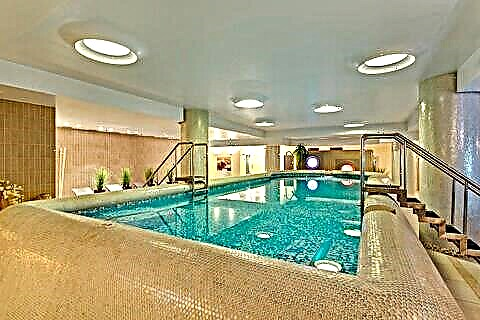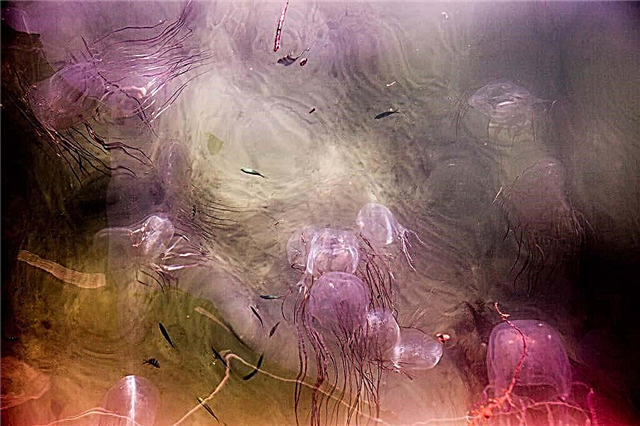Address: Russia, Yaroslavl region, Pereslavl-Zalessky, st. Lugovaya, 7
Foundation date: 1508 year
Main attractions: Cathedral of the Life-Giving Trinity with the Church of Daniel, the Church of the Praise of the Mother of God, the Church of All Saints, the Church of the Tikhvin Icon of the Mother of God
Coordinates: 56 ° 43'12.8 "N 38 ° 50'17.1" E
Content:
Lists of monasteries of Pereslavl-Zalessky
The ancient monastery has stood on the southern outskirts of Pereslavl for over 500 years. His Trinity Cathedral is the second oldest in the city after the Transfiguration of the Savior. This magnificent temple, built in 1530-32, for many centuries it surprises with its beauty and laconism of forms and pleases with perfectly preserved frescoes of the 17th century - real masterpieces of monumental painting.
The life of the creator of the monastery, Daniel Pereyaslavsky
The founder of the monastery, revered by believers as a saint, was born in 1460 in Pereslavl. In the world he was called Dmitry Konstantinov. At the age of 17, he made a decision and independently went to the Kaluga Svyato-Pafnutyev Borovsky Monastery, where he became a monk. 12 years later, Daniel returned to his native Pereslavl and began to live in Nikitsky, and after 1495 - in the Goritsky monastery. Here he went from a monk to an archimandrite for 30 years.

Cathedral of the Life-Giving Trinity with the Church of Daniel
A special ascetic aspiration of Daniel was in the search for wanderers who died on the roads, killed by robbers, frozen and other people who received an accidental death on the way, who were not taken by their relatives. Daniel buried the found bodies according to Christian customs in the skudelnitsa. This is how the churchyards and places of mass burial were called earlier.
In 1508, Daniel built a wooden Church of All Saints on the site of the burial of the unfortunate. With the help of the boyars Chelyadnins, with whom he was a confessor, Daniel received permission from Grand Duke Vasily III Ivanovich to build cells for a new monastery near the church. So he became the abbot of a new monastery, which at first bore the name of All Saints after the name of the temple.
At the insistence of Vasily III, Daniel left Gorits in 1525 and devoted himself entirely to serving in the new monastery he created. Before his death, at the request of Daniel, his disciple Hilarion was appointed abbot. The founder of the monastery died in 1540. He was canonized by the Church as a saint (1653).
History of the Holy Trinity Monastery
Until his death (1533), Vasily III patronized the monastery, he venerated Daniel as his confessor and came to Pereslavl many times. On the occasion of the birth of the long-awaited heir, Vasily III allocated money for the construction of the large Trinity Cathedral, and Daniel became the godfather of the son of Vasily III, the future Tsar Ivan the Terrible (1530)... The monastery was also patronized by the younger brother of Vasily III - Dmitry Ivanovich Zhilka, who ruled Uglich.

Cathedral of the Life-Giving Trinity with the Church of Daniel
When Ivan the Terrible became Tsar, he ordered one of the monastery novices to compile a biography of the Monk Daniel, including in it all the information available at that time about the founder of the monastery. This work was done by one of Daniel's disciples - Athanasius, who later became the Metropolitan of All Russia.
During the Time of Troubles, the monastery suffered greatly. Its buildings were ravaged and burned, the peasants who were subordinate to the monastery were killed, and their houses were plundered (1615). Only the stone buildings erected under Daniel have survived. Later, the monastery spent a lot of effort and money on restoration. And life in it, as in all of Pereslavl, by the middle of the 17th century began to improve.
Over the next half century, the monastery becomes one of the richest in the area. He owned many villages and villages with people living in them. At that time, it was the only one of all Pereslavl monasteries that was completely rebuilt in stone. Boyars Baryatinsky helped the monastery a lot with money. Ivan Petrovich Baryatinsky spent his last years in it and was buried here in 1701 as Elder Ephraim.
In the 18th century, a city theological seminary was located on the monastery territory, and later - a school. And until 1918, it was considered a second-class monastery under the leadership of the Vladimir and Suzdal Diocese. In the mid-1920s, the monastery was closed. During the years of Soviet power, a machine and tractor station was located on its territory, in 1945 - a camp for German prisoners of war and a training military unit. Church services were resumed within the monastery walls in 1995.

From left to right: Cathedral of the Life-Giving Trinity with the Church of Daniel, Church of All Saints
Architectural monuments on the territory of the monastery
The very first stone building of the monastery was the Trinity Cathedral (1530). The famous Rostov architect Grigory Borisov was invited to build it... He worked with his own artel of craftsmen, of which the names of Tretyak Borisov and Pakhomiy Goryainov have survived to this day. Rostov craftsmen became famous for the construction of cathedrals in the Borisoglebsky monastery near Rostov the Great and the Assumption Church in the Spaso-Kamenny monastery on the lake. Kubensky.
Grigory Borisov built a monumental temple with graceful proportions in Pereslavl. It is based on four massive pillars, and the volume is almost cubic. The big head of this church stands on a high and wide drum of light.
Initially, the zakomaras of this temple were keeled. But now this is not noticeable, since they are hidden under a practical hipped roof created later. The interior of the temple is illuminated by narrow drum windows and walls. The cathedral turned out to be great and immediately became the architectural dominant of all the southern outskirts of Pereslavl.
In 1660, a separate small church was added to the Trinity Cathedral over the place where the founder of the monastery, the Monk Daniel, was buried. And this graceful one-domed church formed a harmonious ensemble with a massive majestic cathedral.

Church of the Tikhvin Icon of the Mother of God
Two years later, the interior of the cathedral began to be painted by the famous artel of Kostroma and Yaroslavl painters, headed by Sila Savin and Guriy Nikitin. But due to the large number of orders from the royal court, they did it intermittently and supposedly completed the painting only in 1668. Some frescoes by these masters are well preserved, and we can admire them even today, for example, the image of the Almighty Savior on the cathedral dome or the expressive scene of the Last Judgment.
In 1689, architects invited from Kostroma added a hipped-roof bell tower to the Danilov border. The monks began to use its lower floor for household needs, and a monastery sacristy was placed upstairs.
To the east of the main cathedral is the small All Saints Church (1687). This stone church was erected on the site of the very first wooden church of the monastery by the efforts of Kostroma craftsmen. The stone church is crowned with a beautiful dome on a high drum, decorated with a row of kokoshniks. It was originally built at the hospital. But the hospital building has not survived to this day.

All Saints Church
In the southeastern part of the monastery there is a beautiful Church of the Praise of the Mother of God (1695). It is not for nothing that this temple is referred to as real monuments of ancient Russian architecture. He is very handsome in appearance. Attention is drawn to intricate carved capitals and platbands, skillfully made decorative "shells" and columns. On the second floor of this temple there is a large Refectory Chamber, as well as a variety of outbuildings. The entire building is now being actively restored.
The monks traditionally lived in the two-story Brothers building (1696), which stands on the south side of the Refectory.It consists of monastic cells and rooms for household needs. Previously, the building was adjoined by a utility yard with stables, hayloft and barns. In the cellars of the Fraternal Corps, the monks kept food on the ice.
The last stone church of the monastery is the gate church of the Tikhvin Icon of the Mother of God (1889). She crowns the Holy Gates, made in the stone monastery fence. There used to be a church built over 1700-1702 over this massive gate.

Church of the Praise of the Mother of God
Current state and visiting regime
Today 20 monks live in the monastery. In the 2000s, extensive restoration work was carried out here to restore the stone fence, towers and gates, as well as to partially restore the temples.
You can get to the territory of the monastery any day from 8.00 to 20.00. Anyone can take photos and videos on the territory free of charge. Only monks and church services cannot be filmed. Morning services are held on weekdays at 6.30 am, and on weekends and holidays at 8.30 am. Evening services - daily at 17.30.
How to get to the monastery
The monastery is located at st. Lugovaya, 17. Its architectural ensemble is perfectly visible from the Moscow road crossing the city (highway M8).











